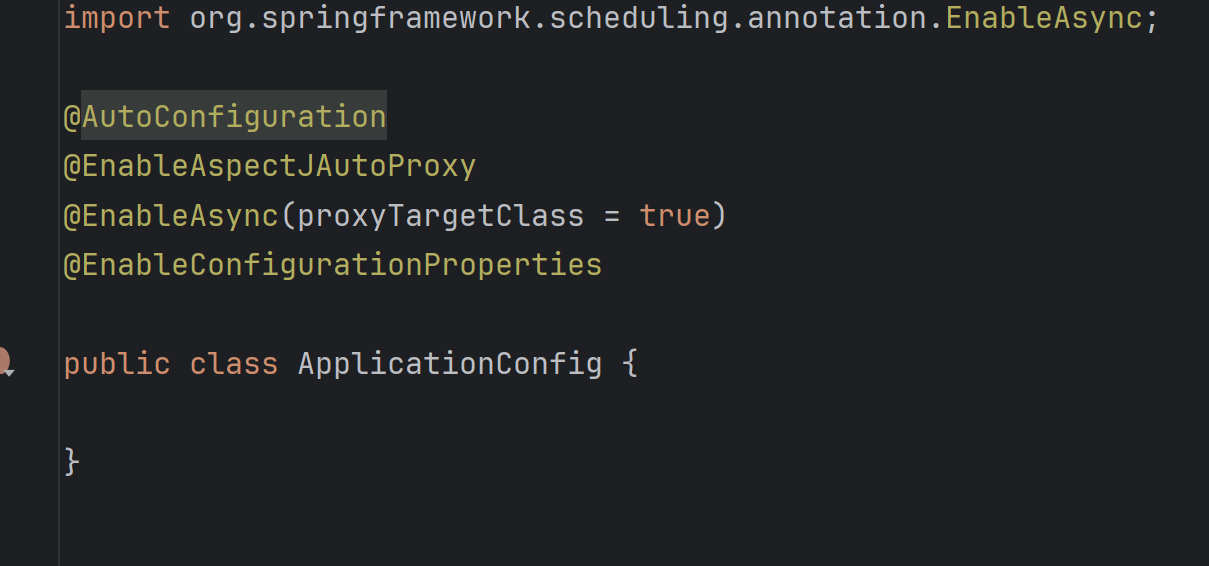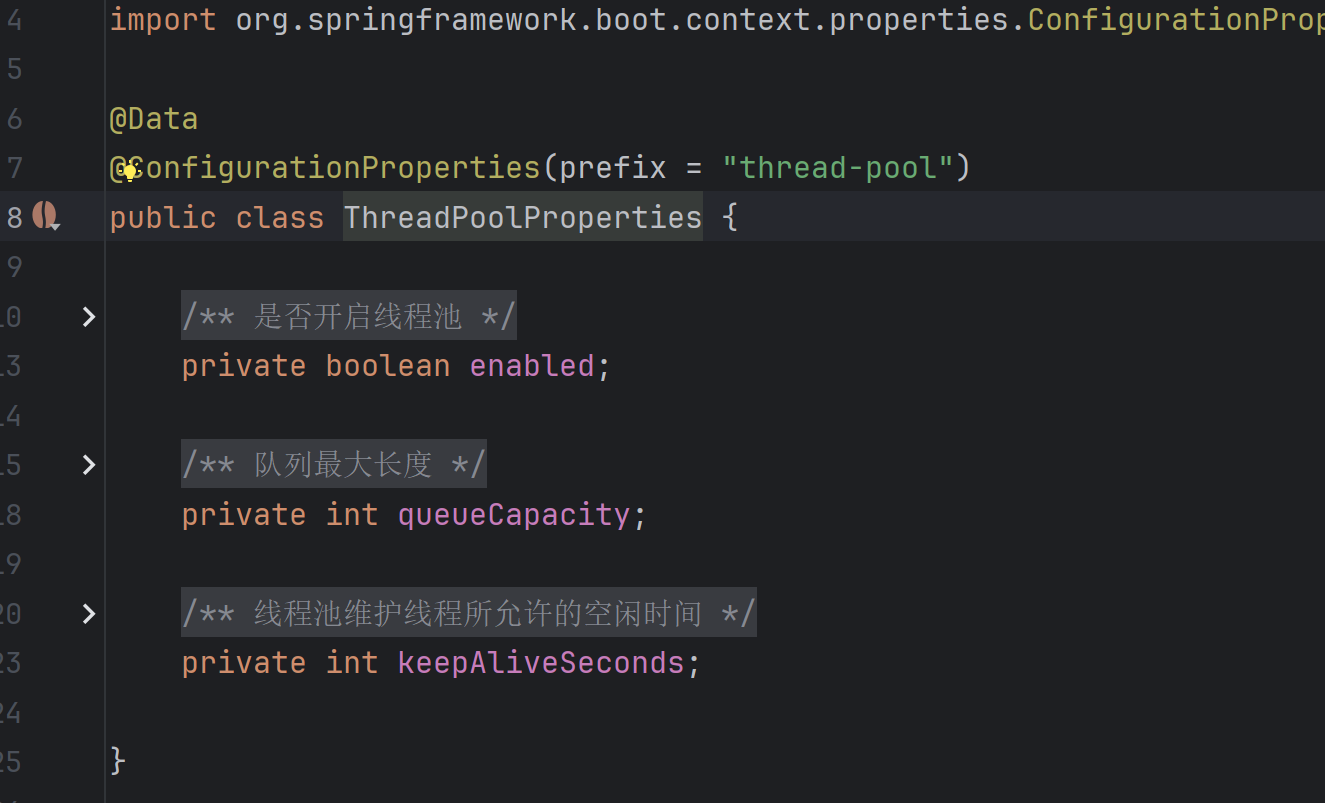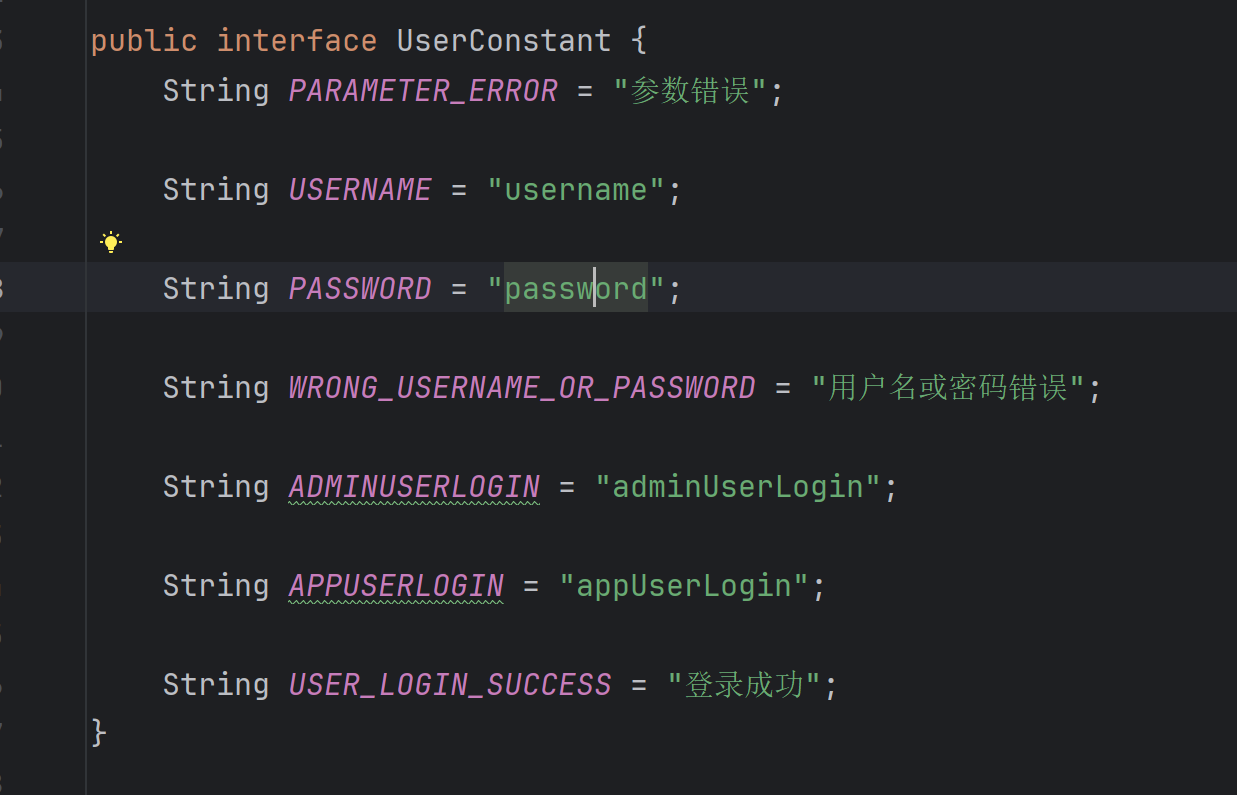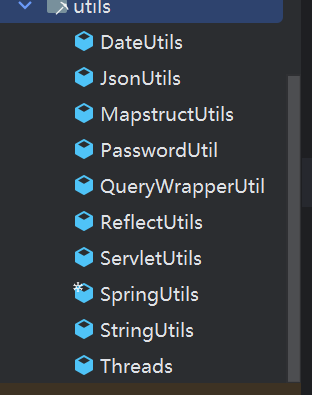这个是对于xiaou-common模块进行的解读。
xiaou-common-bom模块
这个模块为版本管理模块。可以用于模块的一个统一版本管理。
xiaou-common-core模块
这个为通用的核心包代码,也是每个业务模块必须要引入的依赖。
他里面引入了很多常用的依赖,例如hutool,lombok,spring-boot-starter-validation,aop,commons-lang3等。
接下来我们对里面的具体文件具体简述其作用。
config
config目录下目前有三个配置类
分别为
APPlicationConfig

ApplicationConfig 是项目的基础自动配置类
这个也可以写在启动类上面。
@AutoConfiguration
- 这是 Spring Boot 3 引入的注解,等价于旧版的
@Configuration+@EnableAutoConfiguration。 - 表示这是一个自动配置类,Spring Boot 启动时会自动加载该配置。
@EnableAspectJAutoProxy
- 开启 AOP(面向切面编程)自动代理功能。
- 支持通过
@Aspect注解定义切面,例如日志切面、权限切面等。
@EnableAsync(proxyTargetClass = true)
- 开启异步方法支持,即允许使用
@Async注解的方法异步执行。 proxyTargetClass = true表示使用 CGLIB 代理方式而非 JDK 动态代理。
@EnableConfigurationProperties
- 启用 Spring Boot 的
@ConfigurationProperties功能,自动绑定配置文件中的属性到 Java Bean。 - 常配合
@ConfigurationProperties(prefix = "...")使用,用于加载如线程池、Redis、邮件等配置。
其余
剩下的都是跟线程池有关系的。

constan
这个模块放了所有的字符串常量。以及一些redis缓存字段的常量
例如

domain
这个模块存放了我们项目的一个统一结果返回类R
package com.xiaou.common.domain;
import com.xiaou.common.constant.HttpStatus;
import lombok.Data;
import lombok.NoArgsConstructor;
import java.io.Serial;
import java.io.Serializable;
/**
* 响应信息主体
*/
@Data
@NoArgsConstructor
public class R<T> implements Serializable {
@Serial
private static final long serialVersionUID = 1L;
/**
* 成功
*/
public static final int SUCCESS = 200;
/**
* 失败
*/
public static final int FAIL = 500;
private int code;
private String msg;
private T data;
public static <T> R<T> ok() {
return restResult(null, SUCCESS, "操作成功");
}
public static <T> R<T> ok(T data) {
return restResult(data, SUCCESS, "操作成功");
}
public static <T> R<T> ok(String msg) {
return restResult(null, SUCCESS, msg);
}
public static <T> R<T> ok(String msg, T data) {
return restResult(data, SUCCESS, msg);
}
public static <T> R<T> fail() {
return restResult(null, FAIL, "操作失败");
}
public static <T> R<T> fail(String msg) {
return restResult(null, FAIL, msg);
}
public static <T> R<T> fail(T data) {
return restResult(data, FAIL, "操作失败");
}
public static <T> R<T> fail(String msg, T data) {
return restResult(data, FAIL, msg);
}
public static <T> R<T> fail(int code, String msg) {
return restResult(null, code, msg);
}
/**
* 返回警告消息
*
* @param msg 返回内容
* @return 警告消息
*/
public static <T> R<T> warn(String msg) {
return restResult(null, HttpStatus.WARN, msg);
}
/**
* 返回警告消息
*
* @param msg 返回内容
* @param data 数据对象
* @return 警告消息
*/
public static <T> R<T> warn(String msg, T data) {
return restResult(data, HttpStatus.WARN, msg);
}
private static <T> R<T> restResult(T data, int code, String msg) {
R<T> r = new R<>();
r.setCode(code);
r.setData(data);
r.setMsg(msg);
return r;
}
public static <T> Boolean isError(R<T> ret) {
return !isSuccess(ret);
}
public static <T> Boolean isSuccess(R<T> ret) {
return R.SUCCESS == ret.getCode();
}
}exception
这里主要管理一些异常。
首先是有一个GlobalExceptionHandler
通过GlobalExceptionHandler来进行全局异常的处理。
package com.xiaou.common.exception;
import cn.dev33.satoken.exception.NotLoginException;
import com.xiaou.common.domain.R;
import lombok.extern.slf4j.Slf4j;
import org.springframework.web.bind.annotation.ExceptionHandler;
import org.springframework.web.bind.annotation.RestControllerAdvice;
/**
* 全局异常处理器
*/
@RestControllerAdvice
@Slf4j
public class GlobalExceptionHandler {
@ExceptionHandler(BusinessException.class)
public R<?> businessExceptionHandler(BusinessException e) {
log.error("BusinessException", e);
return R.fail(e.getCode(), e.getMessage());
}
@ExceptionHandler(NotLoginException.class)
public R<?> notLoginExceptionHandler(NotLoginException e) {
log.error("NotLoginException", e);
return R.fail("未登录");
}
@ExceptionHandler(ServiceException.class)
public R<?> ServiceExceptionHandler(ServiceException e) {
log.error(e.getMessage());
return R.fail(e.getMessage());
}
}想要添加什么自定义异常可以通过这个类进行一个添加。
同时还有一个异常处理的工具类
package com.xiaou.common.exception;
/**
* 异常处理工具类
*/
public class ThrowUtils {
/**
* 条件成立则抛异常
*
* @param condition 条件
* @param runtimeException 异常
*/
public static void throwIf(boolean condition, RuntimeException runtimeException) {
if (condition) {
throw runtimeException;
}
}
/**
* 条件成立则抛异常
*
* @param condition 条件
* @param errorCode 错误码
*/
public static void throwIf(boolean condition, ErrorCode errorCode) {
throwIf(condition, new BusinessException(errorCode));
}
/**
* 条件成立则抛异常
*
* @param condition 条件
* @param errorCode 错误码
* @param message 错误信息
*/
public static void throwIf(boolean condition, ErrorCode errorCode, String message) {
throwIf(condition, new BusinessException(errorCode, message));
}
}可以在某些场景中避免写try-catch
page
这里放入的是我们的通用分页对象。
我们项目规定,如果要用到分页操作,返回给前端的为pageRespDto。前端需要给我们传入的,我们操作数据库的对象为pageReqDto。这个在后面介绍分页的时候会详细说明。
utils
这里集成了非常多的工具类

我们在编写业务的时候,可以灵活应用这些工具类。
并且我们对commons-lang3的StringUtils进行了集成并加入了很多业务中需要的方法。
public class StringUtils extends org.apache.commons.lang3.StringUtilsspringutils则是对hutool的继承。